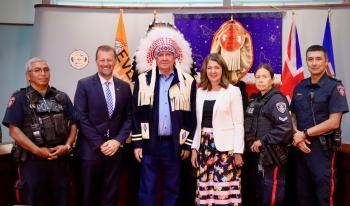Image Caption
Summary
Local Journalism Initiative Reporter
Windspeaker.com
The fourth “recovery community” on a First Nation was announced today by the Alberta government.
This week the province signed separate memorandums of understanding with Tsuut’ina and Siksika Nations June 5 and June 6 respectively, offering each up to $30 million toward the capital costs of 75-bed holistic facilities to be built in their nations.
The facilities will treat both Indigenous and non-Indigenous people with drug and alcohol addictions.
United Conservative Party (UCP) Premier Danielle Smith said the province was stepping up to fill the “unacceptable” void being left by the lack of federal dollars.
In April, the same announcement was made for Enoch Cree Nation.
In 2020 the UCP, then led by Premier Jason Kenney, announced a similar facility for the Blood Tribe but with a funding amount of only $5 million.
That project’s funding has increased now to $30 million, said Hunter Baril, spokesperson for Mental Health and Addictions.
Ground has yet to broken on that holistic facility.
Baril said “there are many factors that come into play, with a large one being COVID-19. We have spent a lot of time working with the Blood Tribe on site selection and design, making sure it works for the community.”
Groundbreaking on the site, located near Cardston, is anticipated “in the coming weeks,” he said.
In announcements for the two newest facilities, Mental Health and Addictions Minister Dan Williams said, “The truth is, is that the addiction crisis has touched all corners of this province. But First Nation Indigenous communities have been hit particularly hard. They disproportionately represent those in crisis and addiction in the province of Alberta.”
In the most recent figures available, a December 2021 report from the Alberta government, with data from the First Nations Information Governance Centre, indicates that First Nations people represented 22 per cent of all apparent accidental opioid poisoning deaths in 2020. That is an increase from 14 per cent in 2016.
First Nations account for only six per cent of the province’s population.
That same report indicated that First Nations people with the greatest opioid poisoning deaths resided in southern Alberta, where both the Siksika and Tsuut’ina Nations are located.
“Drugs have always been with us in every community. But the reality and the severity of drug abuse is changing. It has already changed,” said Tsuut’ina Nation Chief Roy Whitney.
Whitney explained that the recovery community would see a blend of Western medicine and Indigenous teachings. He said a “facility within that facility” would allow for traditional and cultural approaches.
The facilities will start servicing a dozen or so people before eventually ramping up to their 75-bed capacity, said Williams, and serving 300 people annually. The province will pick up the costs with people allowed to stay for up to a full year.
There will also be wraparound services offered, such as housing and employment, to ensure success once leaving the facility.
“This is a recovery-oriented system,” said Smith, “and this aspect…is partnering with First Nations so that we can build out the recovery communities.”
Involuntary treatment, which is part of a Compassionate Care Intervention Act being developed by the UCP government, is part of the recovery-oriented system. However, it would be the “final step,” said Smith.
The Compassionate Care Intervention Act is based on the approach to treating drug addictions undertaken by Portugal. It includes “dissuasion commissions,” which are civil institutions that deal with people and drug offences.
Smith said dissuasion commissions in Alberta would have two-arms, which would include a panel of Indigenous Elders, who would hold Indigenous people to account.
“Every part of what we want to do is going to be culturally sensitive and make sure that it’s appropriate to the community,” said Smith.
Siksika Chief Ouray Crowfoot said he had no concerns with involuntary treatment.
“In Siksika, our way is more extreme than what they’re mentioning. Our way is to intervene,” he said. “We’re not raised to sit back and let somebody self-destruct.”
Whitney was also supportive of the UCP’s move away from harm reduction to a recovery-oriented model, something that started under Kenney in 2019.
“I stand with the premier and her Cabinet on the track that they are creating,” he said. As for safe consumption sites, he added, “More and cheaper drugs handed out by government? That is not a solution.”
As connecting with the land will be important in the traditional healing path offered to First Nations people, the location of the recovery communities will also be important. Those sites, including the one in Enoch Cree Nation, still have to be selected.
With construction expected to begin in 2024, Crowfoot said he is hopeful that the recovery community can be fully operational in 18 months to two years.
As for the impact such a facility would have on his community and the surrounding area, Crowfoot said, “I strongly believe the more we fix ourselves and get our foundation solid, that’s going to bleed out. That’s going to bleed out to Calgary. That’s going to bleed out to Alberta. That’s going to bleed out to Canada.”
Alberta will be establishing 11 recovery communities. The first facility recently opened in Red Deer.
Local Journalism Initiative Reporters are supported by a financial contribution made by the Government of Canada.

